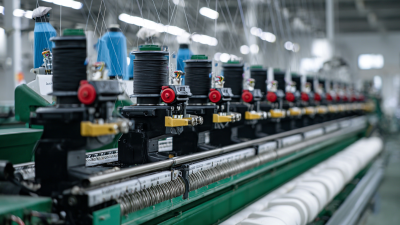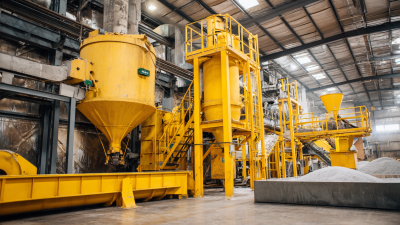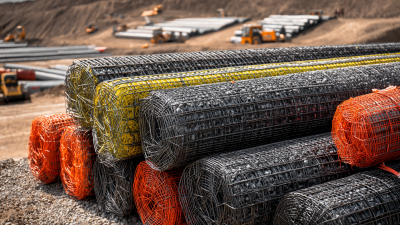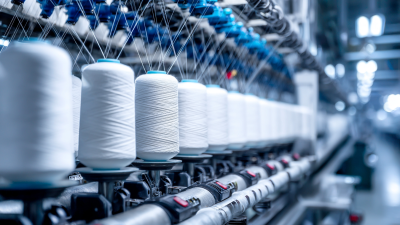7 Best Uses for Separate Needle in Modern Manufacturing
Table of Contents
- Innovative Applications of Separate Needles in Robotic Manufacturing Systems
- Efficiency Gains: Separate Needle Technology in Precision Textile Production
- Impact of Separate Needles on Quality Control in Additive Manufacturing Processes
- Cost Reduction through Separate Needle Integration in Mass Production Lines
- Enhancing Customization Capabilities with Separate Needle Solutions in Manufacturing
- Trends in Separate Needle Use for Sustainable Practices in the Manufacturing Sector
- FAQS
- Conclusion
- Related Posts
In today’s manufacturing world, bringing in new tech is absolutely crucial if we want to boost productivity and get things running more smoothly. One cool innovation that’s been making waves is the use of ‘Separate Needles’ in warp knitting machines — it’s really gaining traction, especially in the textile and composite materials scenes. Industry reports are pointing out that worldwide demand for multiaxial and biaxial fabrics is set to jump significantly, thanks to their applications in sectors like automotive, aerospace, and construction. Companies like DANYANG YIXUN MACHINERY CO., LTD are really leading the charge here. They focus on making top-of-the-line multiaxial and stitch bonding warp knitting machines, mainly for glass fiber and textile industries. Using Separate Needles strategically helps manufacturers streamline their knitting processes, boost fabric quality, and broaden the range of materials they can produce. That gives them a pretty strong edge in the market. As the industry keeps evolving, it’s clear that the role of Separate Needles will be even more important in pushing forward new, innovative manufacturing methods.

Innovative Applications of Separate Needles in Robotic Manufacturing Systems
You know, the way separate needles are being
integrated into modern robotic manufacturing has really opened up some
exciting new possibilities, especially in areas that demand pretty high
precision and adaptability. One standout example is in minimally invasive surgeries—
think robotic liver operations. Having separate needles here actually helps improve haptic feedback, giving
surgeons a better feel for what they're working with. This means they can navigate the complicated shape of
the liver with much more accuracy. And honestly, this kind of progress not only benefits patients with better
outcomes but also boosts the surgeons’ performance by providing real-time tactile info—that's a
game changer.
In the textile and clothing biz, things are getting pretty innovative too.
Automated cutting and sewing machines are now using separate needles, which makes the whole process more
flexible and efficient—perfect if you’re into Industry 4.0 stuff. With these advanced needle setups,
manufacturers are able to pull off more elaborate stitches and intricate designs, improving the quality of
their products while also cutting down on production time. Pretty cool, right?
Here are some tips if you're thinking about jumping into the whole separate needle thing:
- Make sure your team gets proper training so everyone can really get the most out of these systems.
- Stay on top of new tech that could make your needle automation even more precise and effective.
- And don’t be shy about partnering up with tech developers. Customizing needle mechanisms to fit your specific needs can seriously boost your efficiency and the end quality. So, yeah, lots of opportunities to explore!
Efficiency Gains: Separate Needle Technology in Precision Textile Production
You know, integrating separate needle tech into precision textile manufacturing is really a game-changer. I mean, it's a big step forward when it comes to making the whole process more efficient. Lately, I've read some reports showing that automation can cut down material waste by up to 30%. That’s pretty impressive, especially now when everyone’s focusing a lot on sustainability, right? When you mix this separate needle technology with automation, it really helps reduce mistakes and keeps things running smoothly. This is so important, especially with the demand for high-quality textiles that need to be produced faster than ever.
On top of that, innovations like robotic sewing and AI-powered analytics are playing a huge role in this shift. They allow companies to analyze data on the spot, making operations way more streamlined. From what industry experts are saying, using advanced knitting tech and these specialized needle units can bump up overall productivity by at least 25%. Not only does this mean more stuff gets made, but it also aligns with the push for more eco-friendly practices since being efficient means using less energy and lowering carbon emissions. Honestly, I think the future of textile manufacturing will depend heavily on these kinds of tech upgrades — it’s the way to stay competitive and meet the changing expectations for both quality and sustainability.
Efficiency Gains: Separate Needle Technology in Precision Textile Production
Impact of Separate Needles on Quality Control in Additive Manufacturing Processes
You know, in today's world of additive manufacturing, using separate needles has really become a game-changer when it comes to quality control. I came across a report from the Additive Manufacturing Research Institute (AMRI), and it turns out that adding dedicated needles in multi-material 3D printing can actually boost the accuracy of tiny microstructures—by as much as 30%. That’s pretty huge because, in industries like aerospace and healthcare, even small errors can spell serious trouble, sometimes leading to failures or safety issues.
What’s also pretty interesting is that having separate needles gives manufacturers much better control over the material properties as they layer things up. A study in the Journal of Manufacturing Science and Engineering mentioned that companies using different needles for different materials saw about a 25% reduction in waste and rework. It’s a nice bonus because it makes workflows smoother and makes manufacturing a bit greener. Plus, when materials are laid down more accurately, the products stick together better, which means end results that really meet high industry standards—no shortcuts, just solid quality all around.

Cost Reduction through Separate Needle Integration in Mass Production Lines
You know, in today’s world of manufacturing, bringing together separate needles on production lines has really become a
game-changer for cutting costs. I came across a recent report by McKinsey that mentioned
manufacturers who use specialized components like these needles can cut their operational expenses by as much as
15%. It’s pretty impressive because this way, the whole process gets more efficient—since
each needle can be fine-tuned for its specific job, which basically means less waste and better throughput for the machinery.
And get this—Deloitte did a study showing that companies that adopt this tech see a noticeable drop in downtime, with
maintenance intervals stretching out by around 20%. That not only helps save on repair costs
but also gives them more flexibility when it comes to scheduling production. Basically, integrating separate needles helps businesses
make better use of what they already have, and it sets them up for steady growth in a pretty competitive market out there.
Enhancing Customization Capabilities with Separate Needle Solutions in Manufacturing
Nowadays, in the world of manufacturing,
mixing and matching different needle solutions
has really changed the game when it comes to customization. It’s now way easier for businesses to tailor their products to fit what their customers actually want. Using separate needle tech, manufacturers can craft highly specialized items that match individual preferences and current market trends. This kind of customization not only boosts how well the products perform but also gives companies a chance to stand out in a pretty crowded marketplace.
What’s really cool about separate needle solutions is how flexible they are. They let manufacturers speed up their production lines and offer a wider range of products. Being able to quickly switch between different needle types and setups means brands can keep up with the latest trends and consumer preferences—without always having to do major retooling.
It’s a real time-saver, reduces waste, and makes the whole process more efficient and eco-friendly. As manufacturing keeps evolving, it’s clear that this tech will play a big role in shaping the industry’s future — making things more personalized and sustainable all at once.
Trends in Separate Needle Use for Sustainable Practices in the Manufacturing Sector
Nowadays, the way separate needles are used in modern manufacturing is becoming more and more important, especially when it comes to eco-friendly practices. You know, as companies try to cut down on waste and boost efficiency, these separate needles really come in handy. They offer a smart way to handle materials more precisely and make better use of resources. Using them means manufacturers can save energy and raw materials during production—kind of a win-win for the environment.

Plus, it looks like more and more businesses are jumping on the bandwagon with these sustainable methods involving separate needles. They help with recycling efforts too, making it easier to recover materials from scraps. As folks get more interested in eco-friendly products, companies are using this tech not just to look good environmentally but also to boost their reputation. It's a smart move, especially because consumers are more and more into greener options. All in all, embracing this tech isn’t just good for Mother Earth—it’s also a savvy business strategy that keeps companies aligned with regulations and makes them look good in the eyes of customers.
FAQS
: Separate needles are used in robotic manufacturing systems for precise and adaptable applications, notably in minimally invasive surgical procedures and the textile industry, enhancing accuracy and efficiency.
In robotic liver surgeries, separate needles enhance haptic feedback, allowing surgeons to navigate complex liver structures more accurately, improving patient outcomes and optimizing surgical performance.
Separate needles improve automated cutting and sewing technologies, allowing manufacturers to achieve elaborate stitching techniques and intricate designs, increasing output quality while reducing production time.
Separate needles improve quality control processes by enhancing microstructure precision and overall product reliability, with reports indicating up to a 30% improvement in accuracy, crucial for industries like aerospace and healthcare.
Implementing separate needles for different material types can reduce waste and rework rates by 25%, optimizing workflow and sustainability by ensuring accurate material deposition and layer adhesion.
Separate needles facilitate precise material handling and resource utilization, helping manufacturers reduce energy consumption and minimize waste, which promotes environmentally friendly production methods.
Companies are utilizing separate needle technology to improve recycling processes by reclaiming materials from production scraps, aligning with the growing consumer demand for eco-friendly products.
Investing in operator training is essential to fully leverage the capabilities of separate needle systems across different applications, maximizing efficiency and production quality.
Collaborating with tech developers can help customize needle mechanisms to meet specific production needs, thereby maximizing the efficiency and quality of manufacturing processes.
Staying informed about emerging technologies can further enhance the precision and functionality of needle-based automation, keeping manufacturers competitive and innovative in the market.
Conclusion
So, I came across this article called "7 Best Uses for Separate Needles in Modern Manufacturing," and honestly, it’s pretty eye-opening. It dives into all kinds of cool ways this Separate Needle tech is being used across different manufacturing processes. For example, it’s really boosting how robotic systems work—making precision textile production not just easier, but way more efficient. Plus, the article touches on how this tech helps with quality control in additive manufacturing, which is a game changer when you're trying to keep things consistent. And let's not forget about cost savings—this technology is actually making mass production lines more affordable. Another thing I found interesting is how Separate Needles are making it easier to customize products—something consumers are really craving nowadays. The piece also looks at trends, showing how more companies are adopting these needles, partly because they help make manufacturing more sustainable overall.
At DANYANG YIXUN MACHINERY CO., LTD, we’re actually right there with the times. Our team specializes in making advanced multiaxial and biaxial warp knitting machines, and we see firsthand how important Separate Needle tech is becoming. By incorporating smart, innovative needle solutions into our machines, we’re pretty excited about pushing boundaries when it comes to efficiency, quality, and giving customers more options for customization in textiles and composite materials.
Related Posts
-

Unlocking Efficiency: Essential Strategies for Sourcing Spare Parts for Warp Knitting Machines
-

How to Optimize Your Production Line Efficiency with a Multifunction Batching Device
-

The Ultimate Guide to Understanding Geogrid Material for Construction Success
-

How to Leverage Fiberglass Stitched Fabric for Superior Composite Strength and Performance?
-

Innovative Applications of Multi-Axial Carbon Fiber in Aerospace and Automotive Industries
-

How to Maximize Efficiency with Weft-Insertion Warp Knitting Machines in Textile Production

